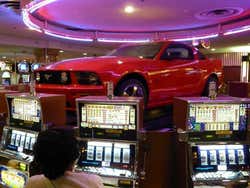
History of Las Vegas
Young, vibrant and forever evolving, it doesn't feel appropriate to use the term 'history' when we talk about Las Vegas. Here we will try to summarize the evolution of the city since its discovery in the 19th Century.
Origins
Las Vegas is situated in a green wetland oasis within the Mojave Desert. Discovered in 1829 by the Mexican trader Antonio Armijo on route to Los Angeles, it was named ‘Las Vegas’ which means ‘The Meadows’ in Spanish.
The area was sparsely inhabited by Paiutes Indians. The first whites to settle there were the Mormons around 1855 when what had been Mexican territory became part of the United States.
In 1864 the army constructed Fort Baker, boosting the population growth. However, it wouldn’t be until the 15th May 1905 when, with the arrival of the railroad, Las Vegas was officially founded as a city.
In 1900, the freshwater springs feeding the grasslands which had given Las Vegas its name were piped into the town. This stabilized population around the fort and allowed Vegas to become a water stop for trains traveling between Los Angeles and Albuquerque.
The expansion of Las Vegas
The expansion of Las Vegas began with the legalization of gambling in 1931. The construction of large hotels with casinos began in 1941, the first two being ‘El Rancho Vegas’ and ‘The Last Frontier’. It is known that many of the first investors belonged to crime syndicates. ‘The Flamingo’, the first luxury hotel and one of the most emblematic, was commissioned by the gangster Bugsy Siegel.
Las Vegas is the city that has grown the most in the United States. In 1940 there were not even 40000 inhabitants, in 1954 it had 54000 inhabitants, in 1995 the metropolitan area had reached a million inhabitants, 1.58 million in 2003, and by 2008 it had surpassed 1.8 million inhabitants. Every month, thousands of people settle in Las Vegas.
As an accompaniment to the gambling halls, musical performances were offered from around 1950. Then came the theatre and today even a circus can be found. The world-famous Cirque du Soleil has permanent shows in Las Vegas.
It is a city that needs to always be offering something new to attract tourists. In the 30s it was gambling, alcohol, and prostitution. Later came musicals, weddings, and express divorces. Today it is family entertainment and other novelties such as the abolition of state taxes for individuals and corporations. It has always been a city on the border of legality, providing its neighbors in Los Angeles with what is normally prohibited for them.

